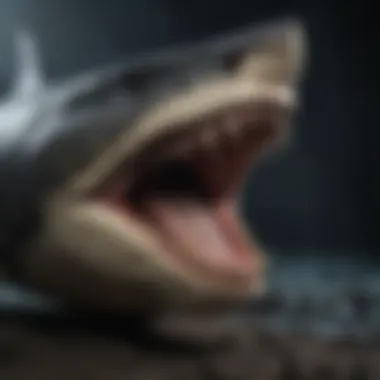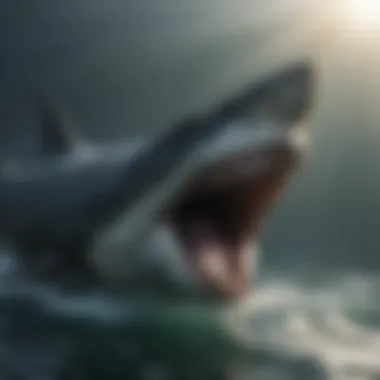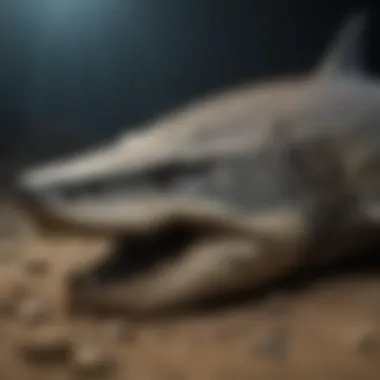Unveiling the Enigmatic Megalodon: A Dive into Prehistoric Mysteries


Rock and Fossil Identification
Understanding rocks and fossils is vital in unraveling the enigmatic Megalodon mysteries. Various types of formations such as sedimentary rocks holding fossil remnants provide crucial clues to the past. When identifying these remnants, key characteristics like texture, coloration, and fossil imprints play a pivotal role. Experts in the field rely on specialized tools like magnifying glasses, UV lights, and sifting screens to enhance their identification efforts, ensuring accuracy in analyzing rock and fossil samples.
Collecting Tips and Techniques
Delving into the world of Megalodon necessitates adept collecting strategies. Enthusiasts must adhere to best practices, such as obtaining permission for collection, respecting conservation laws, and employing proper excavation techniques. Identifying prime collecting sites is a careful process involving research on geological formations, historical fossil discoveries, and expert recommendations. Safely extracting specimens from sites demands precision tools like chisels, brushes, and protective gear to ensure the preservation of delicate fossils.
Preservation and Display
Preservation techniques are crucial in maintaining the integrity of collected Megalodon fossils. Implementing methods such as protective coating, humidity control, and stabilization agents guards against deterioration over time. Proper storage practices involve utilizing acid-free containers, climate-controlled environments, and labeling systems for easy tracking. When it comes to creative display, enthusiasts have the opportunity to showcase Megalodon fossils in innovative ways, using shadow boxes, light effects, and informative plaques to enhance the visual appeal and educational value.
Geological Insights
Exploring Megalodon mysteries unravels significant geological insights into the past. Studying various formations reveals the complex processes that shaped the Earth, from sedimentation to tectonic movements. The historical significance of Megalodon fossils provides a window into ancient marine ecosystems, predator-prey relationships, and climate changes. Remarkable discoveries in the field contribute to ongoing research, expanding our knowledge of prehistoric creatures and the environments they inhabited.
Introduction to the Megalodon
Delve into the captivating realm of the Megalodon, an ancient marine behemoth that continues to intrigue scholars and enthusiasts alike. This section serves as a crucial gateway into the enigmatic world of this colossal predator, shedding light on its origins, characteristics, and the various theories surrounding its existence. By understanding the significance of the Megalodon, readers can gain a comprehensive insight into its evolution and impact on prehistoric marine ecosystems.
Ancient Marine Behemoth
Era of the Megalodon
The Era of the Megalodon stands out as a pivotal phase in the history of marine life, characterized by the dominance of this apex predator in ancient oceans. This era, marked by unparalleled biodiversity, witnessed the Megalodon's reign as a top-tier predator, showcasing its immense size and formidable hunting prowess. Exploring the nuances of the Megalodon's era provides valuable insights into the dynamics of prehistoric marine environments and the evolutionary pathways of marine species.
Geographical Distribution
Analyzing the geographical distribution of the Megalodon unveils its widespread presence across various ancient oceans, underscoring its adaptability and survival strategies. By delving into its habitat range, encompassing different climatic zones and oceanic landscapes, one can comprehend the diverse ecological niches occupied by this marine giant. Understanding the Megalodon's geographical distribution offers key perspectives on its evolutionary adaptability and interaction with regional marine fauna.
Size and Physical Attributes
The size and physical attributes of the Megalodon define its identity as a colossal marine predator, reflecting its exceptional size, unparalleled strength, and distinctive anatomical features. Exploring the dimensions of this ancient giant, including its massive teeth and robust skeletal structure, provides crucial insights into its feeding habits and ecological role. By unraveling the unique size and physical attributes of the Megalodon, researchers can paint a vivid picture of this apex predator's formidable presence in prehistoric oceans.
Historical Significance
Cultural Impact
The cultural impact of the Megalodon transcends scientific realms, influencing artistic representations and popular perceptions of ancient marine life. This section delves into the Megalodon's portrayal in folklore, art, and modern media, highlighting its symbolic significance and enduring appeal. By examining its cultural impact, readers can appreciate the role of this ancient predator in shaping human imagination and storytelling traditions.
Scientific Discovery
The scientific discovery of the Megalodon signifies a pivotal moment in paleontological history, unveiling fossil evidence that revolutionized our understanding of ancient marine ecosystems. This subsection explores the milestones in Megalodon research, from fossil excavations to anatomical reconstructions, showcasing the scientific rigor applied in uncovering its mysteries. By delving into scientific discoveries related to the Megalodon, enthusiasts can trace the evolutionary journey of this iconic predator and grasp its profound scientific implications.
Evolutionary Importance
The evolutionary importance of the Megalodon lies in its position as a key player in marine evolutionary landscapes, influencing the diversification and adaptation of marine species over millions of years. Examining its evolutionary trajectory offers crucial insights into the adaptations and ecological roles of apex predators in prehistoric oceans. By unraveling the evolutionary importance of the Megalodon, researchers can enrich our understanding of ancient marine ecosystems and the forces driving biological evolution.
Characteristics of the Megalodon


The segment on the Characteristics of the Megalodon delves into essential aspects that define this prehistoric predator, elucidating its dentition, feeding habits, and overall adaptations for survival. Detailing the unique features of the Megalodon's teeth, dietary preferences, and hunting strategies offers valuable insights into the behavior and physiology of this ancient marine creature. By analyzing the comparative anatomy of the Megalodon with modern sharks and exploring its potential descendants, this section provides a comprehensive exploration of the evolutionary lineage and biological significance of the Megalodon.
Dentition and Feeding Habits
Megalodon Teeth:
Within the Dentition and Feeding Habits subcategory, the focus shifts towards the extraordinary attributes of Megalodon teeth. These formidable teeth, known for their serrated edges and robust structure, played a pivotal role in the Megalodon's predatory lifestyle, enabling it to grasp and tear through its prey effortlessly. The sheer size and durability of Megalodon teeth allowed it to adapt to feeding on large marine mammals, showcasing its evolutionary advantage in the ancient seas.
- Dietary Preferences:
Dietary Preferences:
Discussing the Dietary Preferences offers a glimpse into the selective nature of the Megalodon when it came to sustenance. By targeting specific types of marine creatures as its primary source of nutrition, the Megalodon exhibited a nuanced approach to feeding that influenced its hunting grounds and ecological niche. Understanding the dietary preferences sheds light on the ecological dynamics of prehistoric oceans and the Megalodon's role in marine ecosystems.
- Hunting Strategies:
Hunting Strategies:
Exploring the Hunting Strategies illuminates the sophisticated tactics employed by the Megalodon in capturing its prey. From ambush tactics to coordinated attacks, the Megalodon's hunting strategies were honed over millennia of evolution, reflecting its mastery as an apex predator. Analyzing the hunting methodologies provides valuable insights into the behavioral patterns and social dynamics of this colossal marine predator.
Adaptations for Predation
Teeth Structure:
The adaptions for predation of the Megalodon are exemplified through its intricate Teeth Structure, finely tuned for capturing and consuming prey efficiently. The robustness of its teeth, coupled with their regenerative capabilities, ensured the Megalodon's sustained success in hunting and consuming large marine organisms. The structural integrity of its teeth showcases the evolutionary adaptations that enabled the Megalodon to maintain its predatory prowess.
- Swimming Speed:
Swimming Speed:
The agility and speed displayed by the Megalodon in its Swimming Speed underscored its tactical advantage in the ancient oceans. By swiftly maneuvering through marine environments, the Megalodon could pursue and capture agile prey with remarkable efficiency. The significance of its swimming speed in the context of predation sheds light on the evolutionary pressures that shaped the Megalodon's physical capabilities.
- Sensory Capabilities:
Sensory Capabilities:
Examining the Sensory Capabilities of the Megalodon reveals the acute sensory mechanisms that guided its predatory behavior. Enhanced senses of smell, sight, and electroreception empowered the Megalodon to locate and track prey over vast distances in oceanic expanses. The interplay of sensory capacities contributed significantly to the Megalodon's prowess as a formidable predator in prehistoric waters.
Comparative Anatomy
Differences from Modern Sharks:
The Comparative Anatomy section scrutinizes the key disparities between the Megalodon and modern sharks, highlighting evolutionary variances and adaptive features. By contrasting anatomical structures and physiological functions, a nuanced understanding of the Megalodon's distinct evolutionary path emerges, showcasing the divergent trajectories of this prehistoric behemoth and contemporary shark species.
- Evolutionary Relationships:
Evolutionary Relationships:
The exploration of Evolutionary Relationships delves into the genetic lineage connecting the Megalodon to its ancestors and potential descendants. Tracing evolutionary markers and genetic adaptations offers a glimpse into the evolutionary history of the Megalodon within the broader context of shark evolution, shedding light on its position within the marine ecosystem and the impact of environmental factors on its evolutionary trajectory.


- Potential Descendants:
Potential Descendants:
The discussion on Potential Descendants speculates on the evolutionary legacy of the Megalodon and the potential modern-day descendants that might trace their ancestry back to this ancient predator. By analyzing genetic markers and ecological niches, insights into the adaptive radiations that followed the Megalodon's extinction contribute to our understanding of evolutionary dynamics in marine ecosystems.
Theories on the Extinction of the Megalodon
In the grand scheme of exploring the mysteries of the Megalodon, delving into the various hypotheses surrounding its extinction holds significant importance. Unraveling the fate of this colossal predator not only sheds light on the evolution and dynamics of prehistoric marine ecosystems but also provides crucial insights into the interplay of environmental factors and biological adaptations over the ages.
Climate Change Hypotheses
Impact of Global Conditions
Exploring the Impact of Global Conditions within the context of Megalodon extinction theories illuminates a pivotal aspect of the discussion. The intricate dance between climatic shifts, oceanographic alterations, and atmospheric changes offers a nuanced perspective on how these global phenomena might have catalyzed the downfall of such a formidable apex predator. By dissecting the specific climatic factors that could have influenced Megalodon populations, researchers can construct more robust frameworks for understanding past extinction events.
Oceanic Shifts
Analyzing the Oceanic Shifts hypothesis unveils a realm of intricate connections between marine environments and Megalodon survival rates. The ebb and flow of ocean currents, temperature gradients, and nutrient distributions all play a role in shaping the ecological niches within which these extinct behemoths thrived. By honing in on the repercussions of oceanic disruptions, scientists aim to piece together a clearer picture of how global changes might have disrupted the delicate balance of marine ecosystems during the Megalodon era.
Temperature Fluctuations
Diving into the realm of Temperature Fluctuations provides a lens through which to examine the intricate dance between Megalodon physiology and environmental conditions. Fluctuating temperatures could have posed significant challenges to these massive predators, influencing their migratory patterns, feeding behaviors, and reproductive strategies. By assessing the impacts of temperature variations on Megalodon populations, researchers strive to elucidate the complex interplay between climate dynamics and biological adaptation in the context of prehistoric oceanic ecosystems.
Competition and Prey Depletion
Unpacking the complexities of Competition and Prey Depletion theories sheds light on the intricate web of ecological relationships that shaped Megalodon's evolutionary trajectory. From shifts in prey abundances to the emergence of new predatory rivals, a myriad of factors could have contributed to the eventual decline of these gigantic marine carnivores. By scrutinizing the repercussions of ecosystem imbalances, researchers endeavor to unravel the multifaceted mechanisms that underpinned the gradual disappearance of Megalodon from the fossil record.
Ecosystem Changes
Examining the implications of Ecosystem Changes offers a glimpse into the cascading effects of anthropogenic and environmental pressures on Megalodon habitats. Alterations in food webs, habitat availability, and resource distributions could have exerted profound impacts on the viability of Megalodon populations, setting the stage for their eventual demise. By untangling the webs of ecological interconnectedness, scientists aim to reconstruct the environmental landscapes in which these prehistoric giants once roamed.
Rise of Competing Predators
Exploring the Rise of Competing Predators narrative unveils a rich tapestry of interspecies interactions and ecological dynamics that may have shaped Megalodon's evolutionary twilight. The emergence of new apex predators, shifts in predatory pressures, and evolutionary arms races could have posed formidable challenges to Megalodon's dominance, driving them towards ecological brinkmanship. By dissecting the implications of escalating predation pressures, researchers seek to illuminate the ecological pressures that heralded the end of Megalodon's reign as the ocean's apex predator.
Food Source Depletion
Delving into the realms of Food Source Depletion offers a window into the shifting landscapes of marine resources and ecological dependencies that may have influenced Megalodon survival prospects. Diminishing prey populations, overexploitation of resources, and ecological imbalances could have constricted Megalodon's foraging capacities, forcing them to contend with dwindling food sources. By examining the implications of resource scarcity on Megalodon ecosystems, scientists endeavor to unravel the complex web of interactions that contributed to their eventual extinction.
Scientific Debates and Ongoing Research
Navigating the currents of Scientific Debates and Ongoing Research opens up a panorama of cutting-edge inquiries and investigative methodologies aimed at illuminating the fate of Megalodon. From molecular analyses to fossil reconstructions, researchers employ a diverse array of tools and techniques to piece together the puzzle of this prehistoric enigma. By synthesizing data from molecular studies, fossil records, and contemporary observations, scientists strive to refine our understanding of Megalodon's ecological legacy and evolutionary trajectory, transcending temporal boundaries to shed light on the enduring mysteries of these ancient marine behemoths.
Molecular Studies
Unraveling the mysteries of Megalodon through the lens of Molecular Studies offers a glimpse into the genetic tapestry that underpins their biological adaptations and evolutionary history. By scrutinizing ancient DNA, gene expression profiles, and phylogenetic relationships, researchers aim to reconstruct the genomic landscapes of these magnificent creatures, unraveling the secrets locked within their genetic codes.
Fossil Record Analysis


Peering through the annals of time via Fossil Record Analysis provides a unique portal into the vanished worlds of Megalodon and its prehistoric comrades. From skeletal remains to fossilized teeth, each fragment unearthed offers a tantalizing glimpse into the anatomical intricacies and ecological contexts that defined Megalodon's existence. By meticulously analyzing fossil data, researchers piece together the puzzle of Megalodon's evolutionary journey, deciphering the clues left behind in the petrified remnants of these ancient marine leviathans.
Modern-Day Observations
Bridging the past with the present, Modern-Day Observations afford researchers a lens through which to contextualize Megalodon's enigmatic legacy within contemporary marine landscapes. By studying extant shark species, coastal ecosystems, and oceanic dynamics, scientists draw parallels between ancient apex predators and their modern-day counterparts, uncovering insights that transcend temporal boundaries. Through the synthesis of historical data and modern observations, researchers aim to bridge the gap between ancient paleontological enigmas and current ecological paradigms, unlocking new vistas of understanding into the enduring legacy of the Megalodon.
Modern Perspectives and Cultural Reverence
In the contemporary study of the Megalodon, exploring its modern perspectives and cultural reverence sheds light on the enduring fascination with this colossal marine predator. This section delves into the significance of understanding how the Megalodon is perceived and revered in current times, providing fresh insights into how this prehistoric giant continues to capture the imagination of scholars and the public alike.
Media Portrayal and Entertainment
Movies and Documentaries:
Movies and documentaries play a pivotal role in shaping popular perceptions of the Megalodon. These visual mediums offer audiences a compelling portrayal of this ancient creature's life, showcasing its immense size, ferocious nature, and the thrill of the hunt. By blending scientific facts with artistic interpretation, these productions not only entertain but also educate viewers about the Megalodon's place in natural history. While some cinematic representations may exaggerate certain aspects for dramatic effect, they remain a valuable tool for sparking interest and facilitating discussions about this enigmatic predator.
Artistic Interpretations:
Artistic interpretations of the Megalodon contribute a creative dimension to its portrayal in various forms of art, ranging from illustrations and sculptures to digital renderings. Artists often emphasize the Megalodon's power and predatory prowess, depicting vivid scenes of underwater engagements and dramatic hunting scenarios. Through their imaginative depictions, artists help evoke a sense of awe and wonder surrounding this ancient apex predator, fostering a deeper appreciation for its role in the marine ecosystem.
Pop Culture References:
Pop culture references to the Megalodon permeate various facets of contemporary society, from advertising and branding to memes and merchandise. The widespread popularity of incorporating Megalodon imagery and themes in mainstream culture reflects a broader fascination with prehistoric creatures and the mysteries of the deep sea. While these references may sometimes oversimplify scientific concepts, they serve to spark curiosity and engage a diverse audience in discussions about paleontology and evolutionary history.
Educational Outreach and Public Interest
In the realm of educational outreach and public interest, initiatives related to the Megalodon play a crucial role in disseminating knowledge and fostering curiosity about this extinct apex predator. By engaging with audiences of all ages and backgrounds, these efforts not only promote scientific literacy but also encourage a deeper appreciation for the wonders of the natural world.
Museums and Exhibits:
Museums and exhibits dedicated to the Megalodon offer visitors a firsthand encounter with the remains and reconstructions of this ancient giant. These immersive experiences provide valuable insights into the Megalodon's evolutionary history, anatomical features, and ecological significance. By showcasing fossil specimens and interactive displays, museums serve as hubs of learning and discovery, inspiring future generations of paleontologists and marine biologists.
Interactive Learning Tools:
Interactive learning tools, such as virtual simulations and online resources, provide accessible platforms for exploring the world of the Megalodon. Through interactive models, educational games, and multimedia presentations, these tools offer dynamic learning experiences that cater to diverse learning styles and foster interactive engagement. By leveraging technology to make scientific information engaging and interactive, these tools enhance understanding and retention of key concepts related to the Megalodon.
Community Engagement:
Community engagement initiatives focused on the Megalodon promote dialogue and collaboration among enthusiasts, researchers, and educators. By organizing events, workshops, and outreach programs, these initiatives create opportunities for networking, knowledge sharing, and interdisciplinary exploration. By fostering a sense of community and belonging within the broader field of paleontology, community engagement initiatives contribute to the democratization of scientific knowledge and the cultivation of a diverse ecosystem of learning and discovery.
Conservation Efforts and Awareness
The conservation of marine life and habitat preservation are integral to ensuring the legacy and importance of ancient marine creatures like the Megalodon are protected for future generations. By advocating for ecosystem health and environmental stewardship, conservation efforts contribute to the broader understanding of human impact on marine ecosystems and the urgent need for sustainable approaches to resource management.
Protection of Marine Life:
The protection of marine life, including sharks and other apex predators, is essential for maintaining ecological balance and biodiversity in our oceans. By advocating for marine protected areas, sustainable fishing practices, and habitat restoration efforts, conservation initiatives aim to safeguard vulnerable species and their habitats from anthropogenic threats. Protecting marine life not only preserves biological diversity but also upholds the intrinsic value of these creatures in the web of life.
Environmental Advocacy:
Environmental advocacy surrounding the Megalodon focuses on raising awareness about the interconnectedness of marine ecosystems and the importance of conservation measures. By addressing key environmental challenges, such as plastic pollution, climate change, and habitat destruction, advocacy efforts seek to mitigate the impact of human activities on marine biodiversity and ecosystems. Through education, outreach, and policy engagement, environmental advocates strive to promote sustainable practices and foster a culture of environmental responsibility.
Policy Implications:
The policy implications of Megalodon conservation span a range of legislative and regulatory measures aimed at preserving marine ecosystems and biodiversity. By developing science-based policies, advocating for conservation funding, and implementing international agreements, policymakers play a crucial role in shaping the future of marine conservation efforts. By integrating scientific research and stakeholder input into policy decisions, governments and organizations can enact measures that support the long-term sustainability of marine environments and the protection of key species like the Megalodon.







